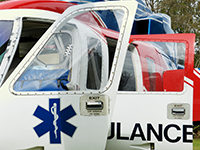A medical emergency, especially when it occurs far from home, can mean transporting a patient thousands of miles at a cost of tens of thousands of dollars. Although many people might think their only option is an air ambulance, there are times when this form of air medical transport is more than the situation requires.
Determining whether an air ambulance is needed starts with a clear understanding of the term “air ambulance.” “Air ambulance” is broad term that describes the transport of patients from an accident scene to a hospital, or from one medical center to another, using fixed-wing aircraft or helicopters. Air ambulances are staffed by trained emergency medical providers and equipped for emergency or critical-care patient transport. Some air ambulance services offer emergency transport only, while others offer both emergency and non-emergency transport.
At an accident scene, the decision to call for an air ambulance is typically made by an emergency responder based on a patient’s medical condition. In other cases, the decision to transport a patient by helicopter or fixed-wing aircraft is made at a hospital by a doctor or the patient’s care team. Depending on the seriousness of the patient’s condition, his or her family may be contacted to discuss options for transport and the medical facility to which the patient should be transported.
If a patient’s condition is stable, patients and their families may have a wider range of transportation options, such as traveling on a commercial airline with or without a medical escort. Both of these choices are less expensive than transport by a helicopter or fixed-wing aircraft. They are also less well-known by those outside the health care field.
So what should family members do if they need to move a loved one long distance in comfort and safety? Consumer Reports magazine recommends asking about transport costs and if an air ambulance is actually necessary before agreeing to use an air ambulance service. In some cases, patients might actually reach a medical center more quickly by traveling on the road in a ground ambulance.
Consumer Reports also suggests that air ambulances are being overused for several reasons, including concerns about legal liability. It also quotes a study published in the Journal of Trauma and Acute Care Surgery that analyzed patient data and found about one-third of patients who were transported to by air ambulance were “minimally injured.”
Medical Transport Services from SentinelMED
Air medical transports on commercial aircraft, typically accompanied by a trained medical escort, are often the best options for patients who become sick or are injured while traveling far from home. In many instances, commercial aircraft are better able to make the long-distance flights required to help patients return home for continued care at medical centers or by family members.
A medical transport service, such as SentinelMED, can help individuals and their family members make important decisions about medical transportation. SentinelMED provides domestic and international medical transport and medical repatriation services for travelers who have more serious or complicated medical concerns. SentinelMED also can arrange for medical escorts to accompany travelers and help them navigate the complexities of long-distance travel. In many cases, traveling by commercial airlines with a trained medical escort addresses the health and safety needs of patients without the exorbitant costs associated with air ambulances.
These services can benefit travelers who suffer a serious injury or illness while far from home, as well as older adults who need assistance when traveling to visit loved ones. The SentinelMED team can arrange door-to-door transportation so these travelers can make the journey in safety and comfort.
The SentinelMED team understands the complexity of delivering exceptional care to patients who need assistance during travel. Please contact us to learn more about the services that SentinelMED offers or its staff.












